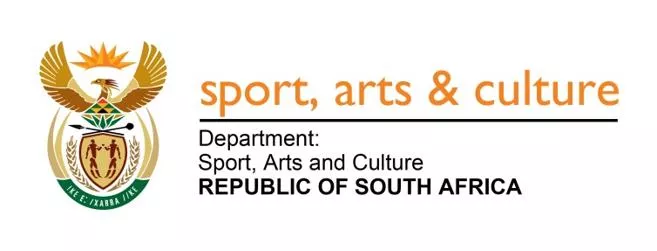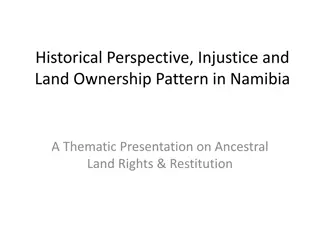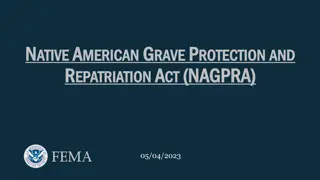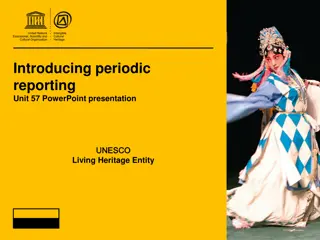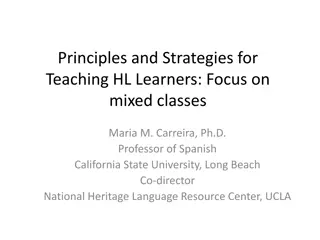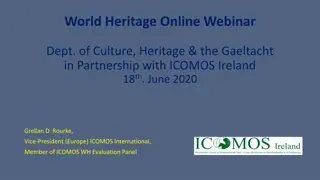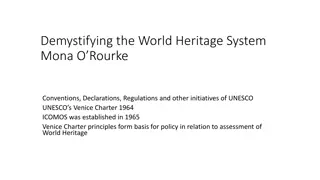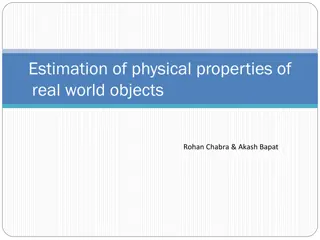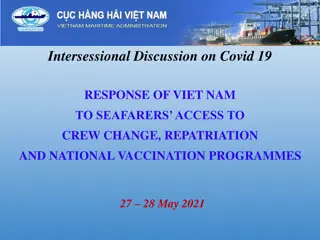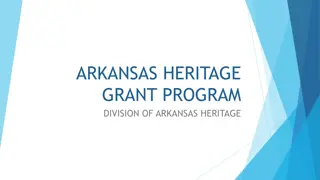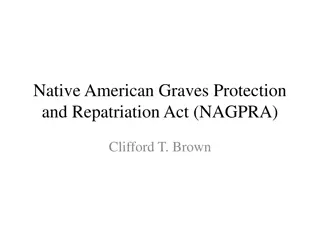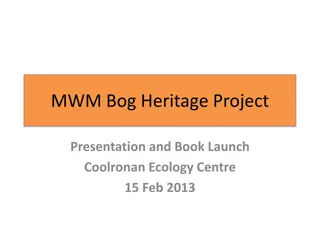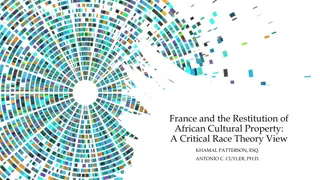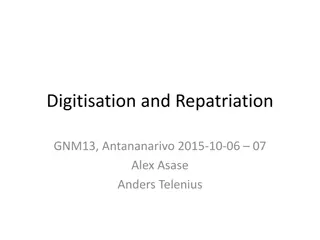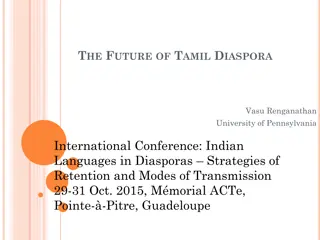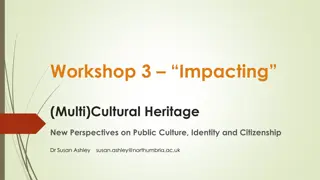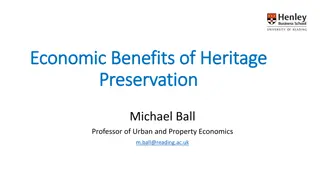National Policy on Repatriation and Restitution of Human Remains and Heritage Objects
The National Policy on Repatriation and Restitution of Human Remains and Heritage Objects addresses the need for repatriation and restitution of human remains and heritage objects related to colonialism, apartheid, and resistance in South Africa. The policy aims to manage requests, claims, and research in a coherent framework to promote healing and reconciliation. It covers human remains and artifacts both within and outside South Africa, emphasizing restorative justice and the importance of cultural heritage in redressing historical inequalities.
Download Presentation

Please find below an Image/Link to download the presentation.
The content on the website is provided AS IS for your information and personal use only. It may not be sold, licensed, or shared on other websites without obtaining consent from the author. Download presentation by click this link. If you encounter any issues during the download, it is possible that the publisher has removed the file from their server.
E N D
Presentation Transcript
PORTFOLIO COMMITTEE NATIONAL POLICY ON THE REPATRIATION AND RESTITUTION OF HUMAN REMAINS AND HERITAGE OBJECTS 27 JULY 2021
TABLE OF CONTENTS 1. PURPOSE 2. INTRODUCTION 3. STRATEGIC FOCUS 4. DISCUSSION 5. IMPLEMENTATION PLAN 6. FINANCIAL IMPLICATIONS 7. RISK / RISK MITIGATION 8. IMPLICATIONS FOR VULNARABLE GROUPS 9. DEPARTMENTS AND PARTIES CONSULTED, RESPONSES AND COMMENTS 10. RECOMMENDATIONS 2
PURPOSE 1. To brief the Portfolio Committee (PC) on the finalization of the National Policy on the Repatriation and Restitution of Human Remains and Heritage Objects. For PC to note that the Policy was presented and adopted by Cabinet Committee at its sitting of the 16 March 2021. 3
INTRODUCTION 2. The policy document presents an opportunity to bring the possibility of the repatriation and restitution of the human remains of those who died during colonialism, apartheid and resistance within a coherent framework for the management of requests, claims and research by the national government as part of the healing and reconciliation of the communities and people of South Africa. This policy covers the remains of South Africans that lie outside the borders of South Africa, on the African continent or overseas, as well as inside South Africa. They could be the remains of people who fell in the line of duty, in military action or in civil society struggles against apartheid. They could also be the human remains of people whose corpses were collected illegally or unethically, which found their way into the repositories of South Africa or overseas. They could be the remains of people which entered the repositories of institutions for the purpose of racial research. It being about human remains restitution and repatriation, this policy also covers material culture, artefacts and documentation that are closely associated with human remains, as grave goods, as bodily depictions or by being collected together. institutions in 4
3. STRATEGIC FOCUS The Bill of Rights in the Constitution (1996) provides rights to cultural, religious and linguistic communities to enjoy their cultural practices. It also affirms that government is committed to the cultural, social and economic upliftment and well-being of all its people without discrimination. Chapter 15 of the National Development Plan indicates that arts and cultural activities can play a major role in healing and restoring pride among South African communities. The White Paper on Arts, Culture and Heritage (2018) emphasizes the importance of heritage in redressing historical inequalities, poverty eradication, employment growth and sustainable development. This policy addresses Sustainable Development Goal 16 (Peace and Justice). The Department of Sport, Arts and Culture will facilitate restorative justice by restoring the humanity of people that were stripped of their humanity and dignity even in their death. 5
4. DISCUSSION Government has been undertaking repatriation and restitution on an ad hoc basis in the absence of national policy and guidelines and Government is unable to practically undertake and carry the costs of the numerous requests it receives for repatriation and restitution from the public and stakeholders. The Implementation Protocol of the Policy include inter alia: o Providing a framework for national and provincial governments in conjunction with communities, to initiate and implement repatriation and restitution of human remains and heritage objects in museums, cultural institutions as well as universities within and outside the South African borders o For the national sphere of government, the Policy provides for the South African government to develop through diplomatic relations, and the 1970 Convention in particular, arrangements with foreign governments to repatriate and restitute human remains and heritage objects which form part of South Africa s national memory and identity. o The policy further provides a framework for provinces to initiate and implement restitution of human remains and heritage objects in government-funded museums and institutions within the borders of their provinces. 6
4. DISCUSSION (Cont.) For human remains and heritage objects held in privately-funded institutions, the policy recommends that the state, on behalf of, and/or together with the requesting individuals, families or communities, enter into negotiations with the privately-funded institutions for the repatriation and restitution of human remains and heritage objects. o No province shall, without the involvement of national government, initiate and implement a project for the repatriation of human remains and heritage objects back into the country, as such remains and objects may fall within the competency of national government. o All repatriation, restitution and reburial of human remains and heritage objects by both national and provincial governments shall be done in conjunction with district and local Municipalities together with other stakeholders. o The repatriation and restitution of human remains and heritage objects by national government (the Department of Sport, Arts and Culture,) shall be implemented through the Repatriation and Restitution Office (RRO) to be established within the South African Heritage Resources Agency (SAHRA). o 7
4. DISCUSSION (Cont.) o The restitution and reburial of human remains (other than remains that fall into the category of national heritage resources) by provincial governments shall be implemented by the Repatriation and Restitution Office to be established within the South African Heritage Resources Agency (SAHRA) working in concert with Provincial Heritage Resources Authorities (PHRA s) or equivalent structures the provincial MEC s may establish. This is so because the repatriation of human remains and restitution of heritage objects are national competencies according to the Heritage Act. o This policy further envisages and recommends close cooperation and collaboration between key national departments o No graves shall be left open or unattended upon completion of repatriation projects whether within or outside South African borders. 8
5. IMPLEMENTATION PLAN The policy will be implemented in a phased approach over a period of 10 years contingent on the availability of resources. Year 1 - Establishment of the RRO o Years 2-3 - Country to Country cases (i.e. Botswana to SA) o Years 4-6 - Country to Country cases (i.e. Tanzania to SA) o Years 7-10 - Country to Country cases (i.e Zambia, Angola to SA) o The demand for repatriation is at this point projected to subside and cases could be conducted as is required and necessary. The policy will be reviewed at regular intervals for effectiveness, efficiency, consistency, progress and impact and finally after 10 years for continued utility and relevance. Implementation of the policy will require close collaboration with all spheres of government and relevant entities. 9
6. FINANCIAL IMPLICATIONS RRO estimated cost breakdown: YEAR ITEM MINIMUM CASES PER COST YEAR 0 ESTIMATES R 5 280 000 1 RRO establishment, capital and operations RRO operations and cases 2-3 3 R 4 000 000 4-6 RRO operations and cases 6 R 8 254 000 7-10 RRO operations and cases 20 R13 127 200 10 TOTAL 28 R30 661 200 All activities or duties relevant to the mandates of other relevant government departments shall be funded from the budgets of those departments. 10
7. RISK / RISK MITIGATION The main risk may be that Government may not be able to carry the cost of all the requests for repatriation and restitution projects. Mitigation measures include the establishment of a special fund to carry these costs and requests for repatriation and restitution to be approved on a strictly case by case basis. 8. IMPLICATIONS FOR VULNARABLE GROUPS During the 19th and early 20th centuries; the remains of many people were taken from their graves to be studied as part of racial science. Today, these people are still mourned. To repatriate and restitute these remains and ultimately rebury them, is but a means of restoring the dignity of the affected families and communities. Similarly, many objects that are deemed sacred or important to communities have in the past been taken from them and placed in museums worldwide. These communities are proud of their heritage and require these objects to be returned to them. 11
9. DEPARTMENTS AND PARTIES CONSULTED, RESPONSES AND COMMENTS The Department hosted roadshow workshops to provinces to discuss the draft policy and to obtain inputs from communities themselves. 9.1 9.2 The Department also held seven national consultative workshops on the draft policy, which was attended by stakeholders such as museums, universities, government departments, curators of human remains collections, experts as well as members of civil society. 9.3 Many inputs and comments were received at these workshops and these comments and inputs were incorporated into the Policy. 9.4 The Policy was recommended for approval by the Social Protection, Community and Human Development (SPCHD) Cluster on 2 June 2020. 9.5 The policy was ultimately presented to the Cabinet Committee on the 16th of March 2021 and ultimately to Cabinet on the 24th of March 2021. 9.6 Whilst the Policy was approved, Cabinet noted that more work would be done, especially on the comments made by Members (dated 16 March 2021). Cabinet approved with the following directives: 9.6.1 Developing clear criteria according to which human remains should be repatriated. 9.6.2 Clarifying how requests for repatriation and restitution would be dealt with. 9.6.3 Ensuring that there is sufficient resources and a common inter-governmental understanding and approach, and Clarifying the financial implications. 12
10. RECOMMENDATIONS The Portfolio Committee to note the adoption of the National Policy on the Repatriation and Restitution of Human Remains and Heritage Objects by Cabinet. 13



